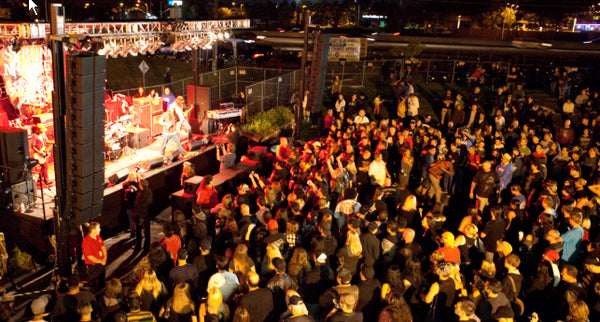-
Audio
-
Guitar
-
Bass
-
Blog
-
SALE
- Financing
- Support
- SINCE 1946
November 14, 2016

If you’re used to playing in small to medium indoor venues, a large outdoor gig may seem a little intimidating, especially if it’s your first time playing one. For the most part, getting a great bass sound in a large outdoor venue is a different beast, although not completely so- there are a few adjustments that need to be made. Here we will cover the main differences between indoor and outdoor venues and give you a few tips to get an optimal sound outdoors.
Indoor vs Outdoor Venues
In your standard bar or club, your bass sound has plenty of walls to bounce off and likely a shorter distance to travel to reach the audience. Outdoors, all those walls and boundaries that contain and amplify your bass sound are gone, and as a result, you may have a more difficult time hearing yourself. Here are some things you can try to prevent your bass sound from getting lost.
1. Power Up. When you don’t have boundary reinforcement, it’s a good idea to bring a more powerful amplifier setup. Extra volume and headroom can go a long way in an outdoor gig, and it can even be as simple as bringing an additional cabinet to give you that extra push. If your go-to club rig is a B2000 with a BR410, for instance, bring an extra BR410 to an outdoor show for a killer live stack. Not only will this beef up your volume output, it will also raise the speakers closer to ear level, making it easier for you and your band mates to hear your rig onstage.
B2000 Lightweight Mono Block 2050W Bass Amp Head
Adding another cabinet will not only give you increased speaker surface area, but it will pull more power from your amp. The B2000 with two four-ohm BR410 speakers lets you run the amp at two ohm full power operation, which is perfect for big outdoor gigs. With any amp, however, it is extremely important to keep in mind impedance restrictions when adding another speaker. For more on this topic, check out this article.
2. Avoid overkill. While an outdoor gig may seem like a great chance to take the stage with a towering amp setup of doom, keep in mind that the PA is going to be there to help. Your rig’s primary job is to cover the stage- the PA is going to cover the FOH and do most of the heavy lifting getting your sound to the audience. Just like in an indoor venue, excessive stage volume can really hurt your band’s live sound, so don’t crank it up too much. You generally will need more volume outdoors, but not so much that it drowns everything else out. It’s a fine balance.
3. Check your EQ. Midrange is always your friend, but especially so in an outdoor setting. Big, beefy lows sound great in small venues where they have walls to bounce off of, but outside it’s a different game. Use your amp’s midrange control. If you have a parametric EQ control, that’s even better! During sound check, dial in a nice present midrange. This is what both the audience and your band mates will hear through the mix.
4.Try a wireless system and/or in-ear monitors. The freedom of movement afforded by a wireless system like the Carvin Audio UX1200 is especially great on a large outdoor stage. It untethers you from that spot right in front of your amp and lets you find the sweet spot to stand onstage. For instance, if the monitors at the front of the stage are set few and far between, you’ll still be good to go. In-ear monitors are also extremely useful outdoors as they let you hear yourself clearly anywhere on stage.
Next time that outdoor festival gig comes calling, approach it with confidence!October 02, 2025
Discover the features and performance that the WG6 Wireless Guitar/Bass System has to offer. The WG6 Wireless Guitar/Bass System is designed to give you the wireless freedom you have been looking for and the simplicity to make your life as a working musician easier. Advanced wireless technology, multiple channel capability, premium audio processors make the WG6 the leader in compact wireless instrument systems. Defined and detailed low frequency response makes this system especially useful for bass players. The WG6 works with both active and passive instruments and is perfect for both electric and acoustic guitar/bass.
March 28, 2025
At any time at any gig, something is bound to go wrong and you may need a tool to get you back up and running. Here are a few basic tools you should bring to every gig.
January 09, 2025
I once asked blues legend Walter Trout why he still plays his well-worn vintage Strat. The technology exists to digitally scan the guitar and make very accurate replicas. His response was he could leave it at home, but then it will never be played. Plus, someone could steal it from his home. At least the guitar is with him and he has the pleasure of playing it. But this may not be the same for everyone.
Sign up to get the latest on sales, new releases and more…
NoFraud Frequently Asked Questions
"Make a joyful noise unto the Lord all of the earth; make a loud noise and rejoice and sing praises. Sing to the Lord with the harp and the voice of the psalm." - Psalm 98:4-5
© 2025 Carvin Audio.
Carvin Corp.
POS and Ecommerce by Shopify
